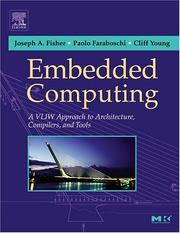| Listing 1 - 10 of 43 | << page >> |
Sort by
|
Book
ISBN: 9783540316145 Year: 2005 Publisher: Berlin Heidelberg Springer Berlin Heidelberg
Abstract | Keywords | Export | Availability | Bookmark
 Loading...
Loading...Choose an application
- Reference Manager
- EndNote
- RefWorks (Direct export to RefWorks)
Embedded systems are ubiquitous. They appear in cell phones, microwave ovens, refrigerators, consumer electronics, cars, and jets. Some of these embedded s- tems are safety- or security-critical such as in medical equipment, nuclear plants, and X-by-wire control systems in naval, ground and aerospace transportation - hicles. With the continuing shift from hardware to software, embedded systems are increasingly dominated by embedded software. Embedded software is complex. Its engineering inherently involves a mul- disciplinary interplay with the physics of the embedding system or environment. Embedded software also comes in ever larger quantity and diversity. The next generation of premium automobiles will carry around one gigabyte of binary code. The proposed US DDX submarine is e?ectively a ?oating embedded so- ware system, comprising 30 billion lines of code written in over 100 programming languages. Embedded software is expensive. Cost estimates are quoted at around US15- 30 per line (from commencement to shipping). In the defense realm, costs can range up to 100, while for highly critical applications, such as the Space Shuttle, the cost per line approximates 1,000. In view of the exponential increase in complexity, the projected costs of future embedded software are staggering.
Digital
ISBN: 9783540319405 Year: 2005 Publisher: Berlin Heidelberg Springer-Verlag GmbH
Abstract | Keywords | Export | Availability | Bookmark
 Loading...
Loading...Choose an application
- Reference Manager
- EndNote
- RefWorks (Direct export to RefWorks)
Digital
ISBN: 9783540316145 Year: 2005 Publisher: Berlin Springer
Abstract | Keywords | Export | Availability | Bookmark
 Loading...
Loading...Choose an application
- Reference Manager
- EndNote
- RefWorks (Direct export to RefWorks)

ISBN: 9781558607668 1417574305 9781417574308 0080477542 9780080477541 1558607668 Year: 2005 Publisher: Amsterdam Elsevier
Abstract | Keywords | Export | Availability | Bookmark
 Loading...
Loading...Choose an application
- Reference Manager
- EndNote
- RefWorks (Direct export to RefWorks)
The fact that there are more embedded computers than general-purpose computers and that we are impacted by hundreds of them every day is no longer news. What is news is that their increasing performance requirements, complexity and capabilities demand a new approach to their design. Fisher, Faraboschi, and Young describe a new age of embedded computing design, in which the processor is central, making the approach radically distinct from contemporary practices of embedded systems design. They demonstrate why it is essential to take a computing-centric and system-design approach to the traditional elements of nonprogrammable components, peripherals, interconnects and buses. These elements must be unified in a system design with high-performance processor architectures, microarchitectures and compilers, and with the compilation tools, debuggers and simulators needed for application development. In this landmark text, the authors apply their expertise in highly interdisciplinary hardware/software development and VLIW processors to illustrate this change in embedded computing. VLIW architectures have long been a popular choice in embedded systems design, and while VLIW is a running theme throughout the book, embedded computing is the core topic. Embedded Computing examines both in a book filled with fact and opinion based on the authors many years of R & D experience. Complemented by a unique, professional-quality embedded tool-chain on the authors' website, http://www.vliw.org/book Combines technical depth with real-world experience Comprehensively explains the differences between general purpose computing systems and embedded systems at the hardware, software, tools and operating system levels. Uses concrete examples to explain and motivate the trade-offs.
Book
ISBN: 0768015669 Year: 2005 Publisher: Warrendale, Pa SAE International
Abstract | Keywords | Export | Availability | Bookmark
 Loading...
Loading...Choose an application
- Reference Manager
- EndNote
- RefWorks (Direct export to RefWorks)

ISBN: 9780824723613 Year: 2005 Publisher: Boca Raton, Fla CRC
Abstract | Keywords | Export | Availability | Bookmark
 Loading...
Loading...Choose an application
- Reference Manager
- EndNote
- RefWorks (Direct export to RefWorks)
Electronics --- Motorcars engineering --- embedded systems --- elektronica --- auto's
Book
Year: 2005 Publisher: Hoboken KDG.IWT
Abstract | Keywords | Export | Availability | Bookmark
 Loading...
Loading...Choose an application
- Reference Manager
- EndNote
- RefWorks (Direct export to RefWorks)
Computer. Automation --- embedded systems --- datastructuren --- UML (unified modeling language)
Digital
ISBN: 9780750677929 0750677929 9780080491240 0080491243 1281006823 9781281006820 9786611006822 6611006826 Year: 2005 Publisher: Amsterdam Elsevier
Abstract | Keywords | Export | Availability | Bookmark
 Loading...
Loading...Choose an application
- Reference Manager
- EndNote
- RefWorks (Direct export to RefWorks)
This comprehensive textbook provides a broad and in-depth overview of embedded systems architecture for engineering students and embedded systems professionals. The book is well suited for undergraduate embedded systems courses in electronics/electrical engineering and engineering technology (EET) departments in universities and colleges, as well as for corporate training of employees. The book is a readable and practical guide covering embedded hardware, firmware, and applications. It clarifies all concepts with references to current embedded technology as it exists in the industry today, including many diagrams and applicable computer code. Among the topics covered in detail are: hardware components, including processors, memory, buses, and I/O system software, including device drivers and operating systems use of assembly language and high-level languages such as C and Java interfacing and networking case studies of real-world embedded designs applicable standards grouped by system application The CD-ROM accompanying the text contains source code for the design examples and numerous design tools useful to both students and professionals. A detailed laboratory manual suitable for a lab course in embedded systems design is also provided. Ancillaries also include a solutions manual and technical slides. * Without a doubt the most accessible, comprehensive yet comprehensible book on embedded systems ever written! * Leading companies and universities have been involved in the development of the content * An instant classic!
Computer architecture. Operating systems --- Computer. Automation --- embedded systems
Periodical
Abstract | Keywords | Export | Availability | Bookmark
 Loading...
Loading...Choose an application
- Reference Manager
- EndNote
- RefWorks (Direct export to RefWorks)
Digital
ISBN: 9783540316640 Year: 2005 Publisher: Berlin Heidelberg Springer-Verlag GmbH
Abstract | Keywords | Export | Availability | Bookmark
 Loading...
Loading...Choose an application
- Reference Manager
- EndNote
- RefWorks (Direct export to RefWorks)
Programming --- Computer architecture. Operating systems --- embedded systems --- informatica --- computerbesturingssystemen --- hardware --- programmeren (informatica) --- computernetwerken --- architectuur (informatica)
| Listing 1 - 10 of 43 | << page >> |
Sort by
|

 Search
Search Feedback
Feedback About UniCat
About UniCat  Help
Help News
News